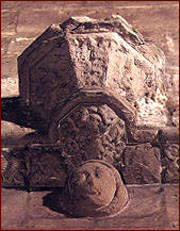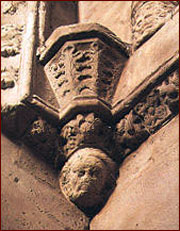
The Mysteries of Rosslyn Chapel
A Testament of Life (from The RoseLine Connection album) by Mark Naples
Recorded in Rosslyn Chapel
To purchase the The RoseLine Connection album please see Mark`s Website
Rosslyn Chapel sits just six miles south of Edinburgh, Scotland's ancient capital city. Built in the 15th century by Earl William St. Clair of Rosslyn, the chapel has become one of the most mysterious and controversial buildings on Earth. Recent years have seen the controversy reach fever pitch as an adversarial band of alternate-history researchers, freemasonic "seekers of light," and treasure hunters vie to unlock the secrets they feel are hidden within the chapel walls.
Rosslyn Chapel has been linked to everything from the Knights Templar and Free Masons to the lost ark of the covenant and the Holy Grail, Even the mummified head of Jesus Christ and the Holyrood (Part of the cross Jesus was crucified on).
So much has been "Claimed" by various authors and magical boffins that separating
truth from fiction has become very difficult indeed. However, If you are
an avid reader of Dan Brown and expect the living relations of Christ to be
near the Chapel, sorry, that is pure fiction.
While it is true that Rosslyn Chapel (Collegiate Chapel of St. Matthew)
holds many mysteries, most are involved in the intricate carvings within its
walls. What today we call Rosslyn chapel, is in fact only a small piece
of the original intended structure.
To view the full extent of the original structure Click Here
(Our thanks to the Rosslyn Templars for allowing us to link to their site)
Building of the Chapel started in 1446 by Sir William St Clair, third and last St Clair Prince of Orkney. The Chapel as we now see it took 40 years to construct, and Sir William who died in 1484 and was buried in the Chapel he had dreamed of building.
A building scheme lasting 40 years and even then not completed, is pretty unique, so why did the Chapel (Part of) take so long to build? First Sir William gathered the best Stonemasons and Carpenters he could find, he hired men from all over Europe. So first he had to organise the building of the Village of Roslin to house his workers. After building their own homes, the workers started on the Chapel foundations, which were for the full Chapel, not just the part we see today. Sir William also contributes to the length of time the Chapel took to build. Insisting that the Carpenters, first made each carving in wood, so he could check it before handing the Stonemasons the plans. This just shows how determined Sir William was that the Chapel should be built to his specifications, so each carving must have meant something to him.
Let’s take a look at some of the carvings at Rosslyn Chapel.
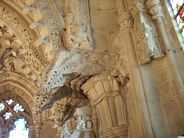
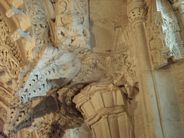
Look at the left hand Photo .. If you look hard enough, at the centre of the photograph, a face appears carved in the stone. The right hand Photo shows the same image zoomed in a little. This image is said to be the death mask of King Robert the Bruce.
Just before Robert the Bruce died (the possible cause was leprosy), in 1329, Bruce asked that his heart should be taken out of his body, and that Sir James Douglas should carry it with him to fight against the Saracens in Spain. Douglas obeyed the king, and the heart was enclosed in a silver casket, Henry Sinclair was one Scottish Noble that travelled with James Douglas.
Both Henry Sinclair and Sir James died in battle, and the casket found under his body on the battlefield.
The heart was returned to Scotland, where it was buried at Melrose Abbey.
Henry Sinclair (1297-1331) and his two sons, John and William, fought at Bannockburn. Robert Bruce rewarded Henry for his bravery with the gift of Pentland Moor. He was one of the Scottish nobles who in 1320 signed the Declaration of Arbroath, which proclaimed to the Pope Scottish independance from England.
The Apprentice Pillar:
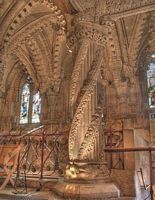
The Apprentice Pillar or the princes Pillar as it was intended to be called, provides Rosslyn Chapel with an endearing legend. The Murdered Apprentice!
Of Course the legend of the murdered apprentice is not unique to Rosslyn Chapel. Rouen Cathedral, Gloucester Cathedral, the Mosque of Damietta, the Great Mosque of Damascus all have similar legends.
An excerpt from 'An account of the Chapel of Rosslyn' written in 1774 by Dr Forbes, Bishop of Caithness describes the legend.
The Master Mason having received from the Founder a model of a pillar of exquisite workmanship and design, hesitated to carry it out until he had gone to Rome or some other foreign part to see the original. He went abroad and and in his absence an apprentice, having dreamt that he had finished the pillar, at once set to work and carried out the design as it now stands, a perfect marvel of workmanship.
The Master Mason on his return, seeing the pillar completed, instead of being delighted at the success of his pupil, was so stung with envy that he asked who dared to do it in his absence. On being told that it was his apprentice, he was so inflamed with rage and passion that he struck him with a mallet, killed him on the spot and paid the penalty for his rash and cruel act.
Left to right Apprentice - Mother - MasterMason
While it is not unusal for the legend of the murdered apprentice, what is unusal is the Apprentice head (With head wound) being carved into the stonework. However perhaps all is not what it seems.
Careful and close up study of the carving of the Apprentice, show that the head
has been altered. Definite chistle marks can be seen on the face where the beard
has been removed. Why would someone alter the carving?
Well at the time of the building of Rosslyn Chapel, Master Masons wore facial hair as a mark of their rank, therefore apprentices, were banned from growing hair on their face until they had learned their trade. So if the head has been altered:
Who did it and when?
Was it done to honour the dead apprentice?
Was it done to encourage the legend?
If the apprentice head is not the original carving, then who are the Mothers head and the masters head? Obviously all three heads originally had completely different significance.
Could it have been Jesus (Bleeding from thorn wounds) .. Mary Magdalene (crying at the death of her husband) .. Judas (Before he hanged himself)
Or perhaps Hiram Abif (Killed by his 3 apprentices) .. His mother (known as the Widow) .. King Solomon (raised Hiram Abiff from the dead)
Unfortunately we will never know, who this three heads were meant to represent, Just another mystery of Rosslyn Chapel.
At the base of the Apprentice pillar you will find eight dragons and from their mouths emerges the vine that winds itself around the pillar.
There may be a link here to Scandinavian Mythology, in which the eight dragons of Neilfelheim were said to lie at the base of Yddrasil, the great ash tree which bound together heaven, earth and hell. The founder's connection with Orkney perhaps provided the inspiration for this symbolism.
Perhaps because of the intricate carvings on the pillar, it has become a magnet for peoples theories. Many claim the pillar has a hollow compartment, and that various religious relics are incased within.
On the architrave joining the pillar, there is the inscription Forte est vinum fortior est rex fortiores sunt mulieres super omnia vincit veritas: "Wine is strong, a king is stronger, women are stronger still, but truth conquers all" Strange but true, this is the only inscription in the whole chapel.

Before leaving the Apprentice Pillar and viewing other carvings, It is worth mentioning that several people have passed comment on the vines around the pillar, and that they appear very similar to DNA strings.
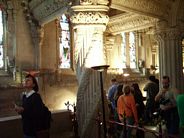
Of course this is just coincidence, as DNA was unheard of in the 14 Century. And perhaps just coincidence that the first DNA cloned Animal, the famous "Dolly" the Sheep, was cloned at the research centre in ROSLIN

The Mysterious Maize Carving
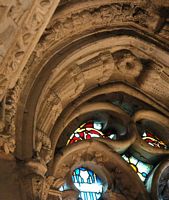
There are the carvings at Rosslyn Chapel, that show maize and aloe vera - plants which at that time were indigenous to North America but carved before Columbus discovered the New World in 1492.
Prince Henry Sinclair was the son of Sir William Sinclair. Prince Henry gained the Earldom of Orkney in 1379. Henry was entitled to the position by way of his mother, Isabella, Countess of Orkney, Scotland.
In 1398 Prince Henry Sinclair was the commander of a fleet of ships that explored the North Atlantic Coast of North America (as yet unproven, but with unauthenticated evidence) He sailed under the Norwegian Flag, as the Orkney's were also an Earldom of Norway. During the visit to North America, Prince Henry Sinclair built a new long ship, and sailed it back to the Orkney Isles.
During this visit to North America, he explored an area known today as Westford, Massachusetts.
While visiting Westford one of the Knights of his military contingent known to have been Sir James Gunn died. A monument to Sir James was “drawn” by punching holes in a rock wall outlining a Templar Knight... This authenticated carving is known today as:
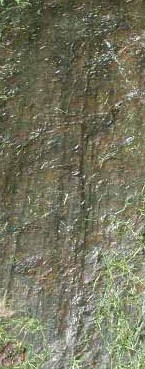
“the Westford Knight”
Prince Henry Sinclair returned to his home in Roslyn, when he discovered that the English were raiding his barony. In the rush to battle to defend his people, and the Highland Clan, he was mortally wounded. Prince Henry was buried in his armor, at the site of the present day Roslyn Chapel.
So what was the reason for this journey to the New world. From records we know he first visited Greenland. This was some 84 years since the brutal ending of the Templars (See other article). Could it have been possible that Prince Henry was shipping the lost Templar treasure to a secret hiding place .. a New World?
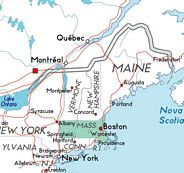
In this map of Massachusetts you can see Nova Scotia on the upper right.
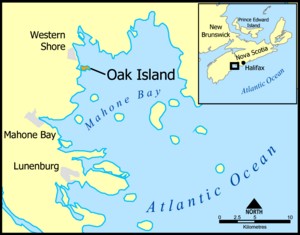
And this is Oak Island off Nova Scotia, home to the famous "Money Pit" Read about the Money Pit Here: http://www.unmuseum.org/oakisl.htm
Perhaps NOT Pirate treasure, But that of the Templar Knights, who were skilled in exclavating while at Solomon`s Temple.
The Ceiling Carvings at Rosslyn
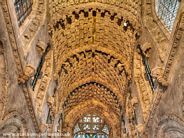
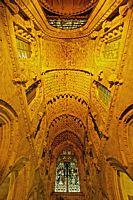
The arched interior of Rosslyn Chapel resembles a mystical cave, dripping with imagery.
THE mystical symbols carved into the stone ceiling of Rosslyn Chapel have mystified historians for generations.
The 213 cubes are believed to be part of a musical notation system that recorded a melody of great spiritual significance to those who built it.
Now a Japanese electronics manufacturer is helping to fund research into decoding the symbols, in the belief that it could lead to the development of a range of muscle-relaxing products using vibrations from sound.
Eight scientists and music specialists from around the world are trying to understand the relationship between the symbols, which to the untrained eye look like a series of uninspiring lines and dots, and musical notes.
One of the theories is that the notes were recorded using a brass plate covered with sand. When the brass plate was struck with a bow, it vibrated, creating a distinctive pattern of sand lines for that particular note.
Stonemasons then took the patterns and carved them into the stonework to record the music played at religious ceremonies in the building.
A recent discovery reported in The Scotsman may add more fuel to that fire. Edinburgh composer Stuart Mitchell believes he has solved the mystery of the 213 decorated cubes on the ceiling: they hold a code for medieval music. Mitchell hopes that the music, when played on medieval instruments, will resonate throughout the chapel unlocking a secret in the stone.
In the chapel, figures of angels playing musical instruments are all around.
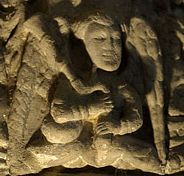
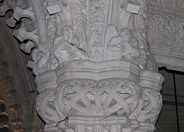
To hear this music here: Rosslyn Music
The Green Men
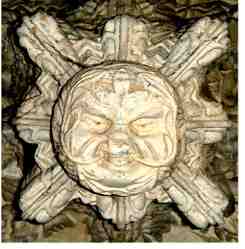
‘The Green Man’, a name coined by Lady Raglan in 1939, is a mediaeval image usually found in churches. Carved in stone or wood, depicted on stained glass, illuminated manuscripts and where else, he can be recognised as a face, often grotesque, with foliage sprouting from his mouth, nose, eyes or ears.
They are commonly thought to be a symbol of rebirth or fertility, pre-Christian in origin. In Rosslyn they are found in all areas of the chapel, with one excellent example in the Lady Chapel, between the two middle altars of the east wall.
While the Greenman is often found, in many Church`s, it is the sheer scale of Green Men at Rosslyn Chapel (in excess of one hundred) that makes it unusual.
Many say that the Chapel is a book in stone, and perhaps this is true, and the Green Men may just help explain this.
They start off on the East side as young men, and then get progressively older as you travel round the church. Is the chapel quite simply the story of life in miniature.
To begin the journey you need to face the two East windows, which are designed to catch the morning light. Opposite these windows are carved musicians, welcoming in the dawn. Facing them is the nativity scene. The whole east section of the chapel is concerned with the beginning of day, the start of life and spring. The green men here are young boys with single vine leaves entwined round their immature faces.
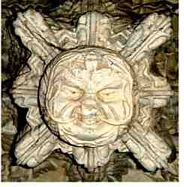
Moving to the south the scene moves on towards the middle of the day, summer and the middle years of life. The foliage depicts harvest time, there are fruits in abundance. Here the green men are in the prime of life, verdant and lush. The biblical lesson is about gaining wisdom, with depictions of the seven deadly sins and the seven virtues.
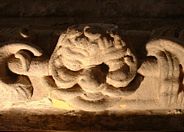
Moving West and dusk falls. The scene is autumnal and the green men are ageing. The roof represents the canopy of the heavens with stars and moons.
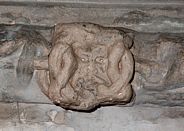
Finally, coming round to the North, the chapel hits winter, the end of the day and the end of life. The green men are skeletons; the biblical story is of the crucifixion. The North aisle is associated with death. It is no coincidence that the only two black slabs in the flooring are placed here. Beneath them a stone stairway leads to the Crypt where the bodies of innumerable Sinclairs lie entombed in their armour.
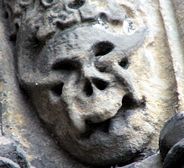
The story of life, carved in stone at Rosslyn Chapel.
Other strange carvings
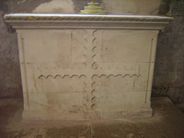
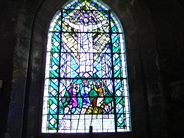
Perhaps, after seeing some of these amazing carvings, we can understand why the Chapel took so long to build. Remember each carving had to be first carved in wood by carpenters, and passed by Sir william, before the Stonemasons even got the diagrams. Why would anyone build such an intricate Chapel in this area unless it was to be the secret place to hide precious relics and vast treasures? Well sorry all grail hunters, My personal theory, is the Chapel was built solely for the reason that Sir William wanted to leave a legacy, something to be remembered by, something he certainly achieved.
Undoubtedly the Templar Knights came to Scotland, perhaps they carried Holy Relics with them, But the area of Roslin was often under attack by the invading English forces, Why try to hide anything in a Chapel, when Roslin Castle and Edinburgh Castle was so close at hand.
I should point out that although I do not believe Sir William purposely built the Chapel to hide Holy Relic`s or treasure, that does not mean that certain items may have been secured in the vaults at a later date. Remember the stonemasons first had to build their own homes before starting the Chapel, the first construction at the Chapel site would, of course be the underground vaults. I presume that the vaults would have been constructed under the "full" plan for the Chapel as it was intended to be, therefore the vaults under the Chapel could extent well beyond what we see of todays building.
The St Clair family do not seem to be closely linked to the Knight Templar, Yet close to Roslin is the village of Temple. We also have Templar Wood at the opposite side of Roslin, Nothing special about that, just a pile of old trees, until you view the wood from the air.
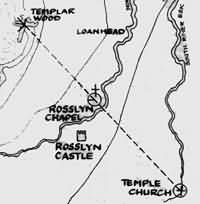
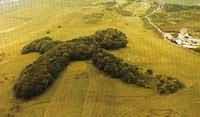
Templar Wood is planted in the form of the Templar Cross. The Templar Cross is more like a "plus" sign than the standard Christian extended upright cross. So there certainly seems to have been Templar activity around the Roslin Estates. Even the St Clair Cross resembles the Templar Cross but engrailed.
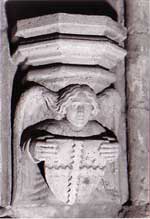
So even if the St Clairs were not Templars, they certainly must have no objection to them living on their land.
The Chapel Today.
Today Rosslyn Chapel is attracting thousands of visitors. Is this a good
thing or a bad thing? Well, certainly the visitors are providing the capital
required to renovate the building, and I am sure the Trust will welcome all
the extra revenue. However everything has a dark side. Thousands
of tourists must cause wear to the old building, the constant touching of the
stone work, the feet wearing the floor down, people walking on the grounds ..
walking over vaults and graves. Then we have the Reclic hunters, Rosslyn
has now become a Relic itself, People are looking to take bits of the Chapel
as souviners .. people have actually been found digging in the grounds, trying
to find the vaults. A piece of the Chapel yard railings, was offered for
sale on Ebay.
Rosslyn Chapel, even today is a working place of worship, an active Church built on hallowed ground. People must learn to respect the nature of the building and what it represents.
We do ourself no favours, by adding a Tea-shop and gift shop selling normal gift shop Tat. But with the amount of visitors it now attracts, really can we blame the Trust for trying to milk every penny they can, so it can be ploughed back into restoring the building.
Rosslyn Chapel is a wonderful Building to visit, I could spend hours there just looking at the carvings, and I will certainly be back in a year or so, just to see how the restoration program is doing. Even if the Holy Grail is buried in the vaults of Rosslyn or the severed head of Christ .. Lets leave it undiscovered! There are things in this World that we should not disturb, and Rosslyn Chapel is one of them.
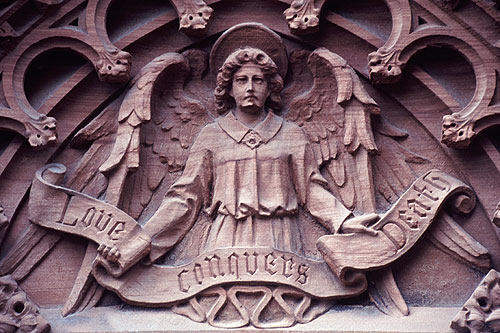
Ian Fyvie









